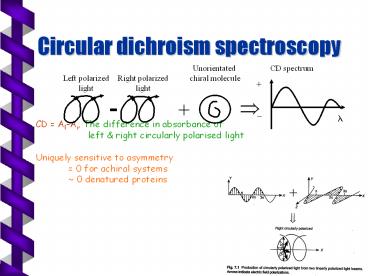Circular dichroism spectroscopy PowerPoint PPT Presentation
1 / 25
Title: Circular dichroism spectroscopy
1
Circular dichroism spectroscopy
CD AlAr The difference in absorbance of
left right circularly
polarised light Uniquely sensitive to asymmetry
0 for achiral systems
0 denatured proteins
CD spectrum
Unorientated chiral molecule
Left polarized light
Right polarized light
-
?
_
?
2
CD Spectra
Varying absorption of circularly polarised light
by chiral molecules results in distinctive
spectra under absorption bands Need
chiral light and chiral molecule to get CD
spectrum of a solution
3
CD spectropolarimeter
Max light intensity 300-400 nm
M mirror Pprism
Quartz 1/4 l- plate. Oscillates at 50 Hz ? CPL
Monochromater prism
CD?A/(absorbance units)4??(degrees)/(180ln10) CD
?(millidegrees)/32,980
4
Empirical analysis of CD
HPLC detector
Structural change
5
CD requires helical electron motion
Require magnetic dipole transition moment ?
0 Require electric dipole transition moment ? 0
6
CD from coupled oscillators
R CD strength Im(?.m) ?electric dipole
transition moment mmagnetic dipole
transition moment
?-? transition of a helical polypeptide
High energy, 190 nm
Low energy, 208 nm
7
Carbonyl CD
?-axial adamantanones
z
y
y
z
?-equatorial adamantanones
8
Tris chelate metal complexes d-d
9
Tris chelate in ligand transitions
?-enantiomer
?-Ru(4,7-dimethylphenanthroline)32
Equal opposite Assign transitions
10
Amino acids, peptides and proteins
11
Protein CD
a-helical protein spectra are distinctive
222,208,190 nm other motifs also have well-
defined spectra CD spectra depend on
AVERAGE solution phase protein structure
Use to determine how environment temperature,
pH, solvent, ionic strength, denaturing
agents alters protein structure. Also
binding constants. Quick easy experiment that
doesnt consume sample
12
CD to answer does it change structure?
Reduced and unreduced plant defensins ??? Can we
use mass spectrometry to give structural
Information want to use 50 MeCN. In fact OK.
13
Protein structure analysis from CD spectra
Distinctive spectra can be described for pure
backbone conformations in the absence of side
chains. In principle, the CD of a native protein
is the sum of the appropriate percentages of
each component spectrum. Must know molar residue
(amino acid) concentration.
CD spectra can be analysed by the
structure-fitting program cdsstr (of C.J.
Johnson) to obtain of secondary structure
motifs. Cdsstr uses a basis set of protein
spectra
Lysozyme CD in molar residue ??
32 helix for lysozyme in water
14
Protein conformation as a function of environment
Tris buffer soluble Pre-PSbW and and Unfolded
using Guanidinium Chloride
Pre-PsbW, thylakoid membrane protein No
structure in guanidinium chloride Some in
tris buffer (multimer) Lots in SDS micelles
(folded, 2 helices)
15
CDsstr results for pre-PsbW
16
Vancomycin ristocetin
Glycopeptide antibiotics that prevent
cross-linking and transglycosylation during
bacterial cell wall formation. Noncovalent
dimerisation plays a key role in their
activity CD used to give binding constants V-V,
V-R and V-peptides, R-peptides. Assume
non-covalent dimers.
CD change (induced CD) ? dimer Kdimerisat
ion 20?5 (mM)-1
V R ?V-R
17
Nucleic acid CD
DNA and RNA polymers sugar units of the backbone
provide the chirality, but not the
chromophores. CD spectrum of a polynucleotide
arises from interaction between the ???
transitions of stacked bases. Magnitude is
larger at 270 nm and much larger at 200 nm
relative to isolated nucleosides. CD to
identify which polymorph CD varies more with
base orientation than sequence
18
Nucleic acid CD spectra
Calf thymus DNA B-DNA (10.4 bases) A-DNA
B-DNA (10.2 bases)
B-DNA 72, 50 31 GC content
Polyd(G-C) 2 B-DNA A-DNA Z-DNA
B-DNA 275gt0, 2580, 240lt0, 220gt/0,
180/190gtgtgt0 ADNA 295lt/0, 260gtgt0, 250?230gt/0,
210ltlt0, 190gtgt0 Z-DNA 290lt0, 260gt0, 195/200ltltlt0,
185 ?1800
19
RNA CNG repeats (neurological disorders e.g.
Myotonic Dystrophy )
Which is melted?
Unusual RNAs adopt duplex A-form plus something
else. ??? Triplex.
20
(No Transcript)
21
Induced CD
DNA is chiral. Achiral ligands upon binding to
DNA acquire an induced CD (ICD) signal into
their own electronic transitions due either
to (I) The DNA structurally perturbing them and
making them chiral, or (II) Their transitions
coupling to those of the DNA and acquiring a
helical element.
50 ?M 9-hydroxyellipticine (planar aromatic
molecule) DNA gives induced CD at ligand
wavelengths
22
Induced CD for binding constant determination
Anthracene-9-carbonyl-N1-spermine (ISB)
ICD??L bound ??(bound ligand)L bound
Induced spectroscopy method
Cant determine bound ??
23
Sample requirements for CD
- Backbone region 250 nm ? 180 nm
- 150 ?L of 0.1 mg/mL (1 mM amino acid, for 20
kDa protein, 5 ?M) 1 mm pathlength - Modified optics focuses light beam to 2 mm x 1
mm, same quality data with 2 ?L sample in 2 mm
wide masked cuvette or 1 mm diameter capillary - 200 ng / sample NON-DESTRUCTIVE!
24
Capilliaries
- Jenway 1 mm quartz capilliaries for UV
absorbance. CD spectra are OK using them either
with focusing or masking. Magnitude was 10
larger than 1 mm rectangular cell 1.1 mm
diameter capilliary. - Same spectrum at 0?,45?,90?! 41 p each!
- Use focused beam or masked beam.
- Seal capilliary or not. Fiddle to fill and get
sample in right place for minimum volume.
A capillary
Sample 36 ?L required
Capillary sealed with wax
25
Cytochrome-c with lens
Lens
Capillary

